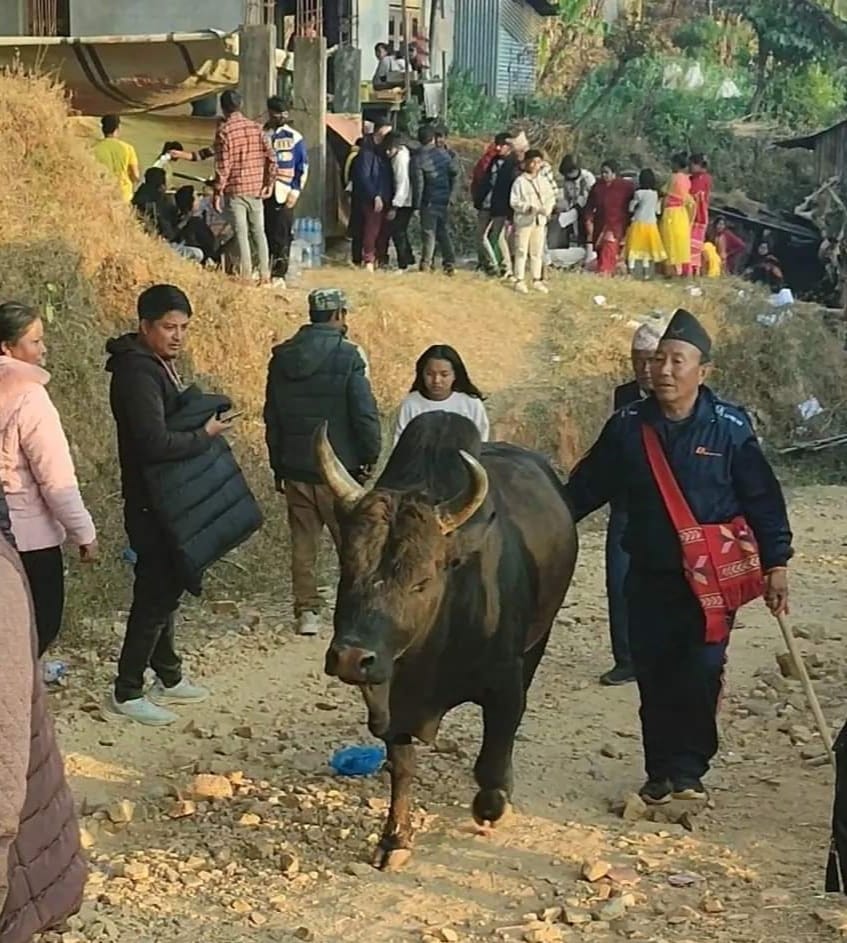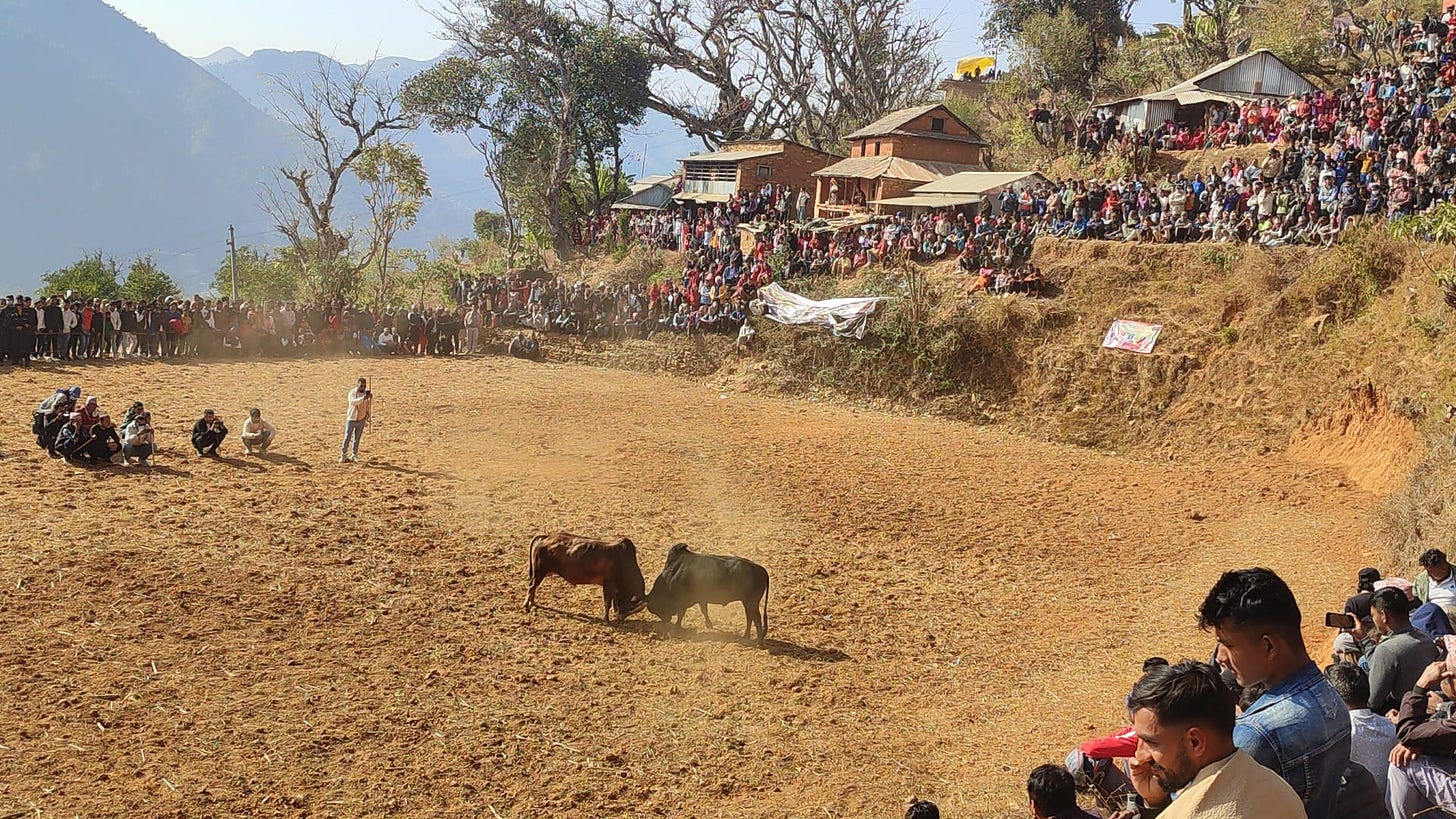The world of entertainment is deeply subjective, shaped by culture, personal values, and regional traditions. Activities like hunting, for instance, are cherished by some as a time-honored tradition and a means to connect with nature, while others vehemently oppose it, viewing it as unethical and harmful to wildlife. Similarly, greyhound racing in the U.S. divides opinion: one side sees it as a thrilling sport that celebrates the speed and agility of dogs, while the other criticizes it for potential animal mistreatment and overbreeding. It is the same with bullfighting in Nepal.
The tradition of ox fighting in Nepal, particularly observed during the harvest festival of Maghe Sankranti, intertwines cultural heritage with entertainment. Bullfighting reflects the shift from the labor-intensive farming season to a time of leisure for both farmers and their oxen. The victorious ox often becomes a local symbol of pride, earning prizes for its owner. This practice, deeply rooted in Nepalese history, began in Nuwakot, Nepal. There has always been a conflict in this matter. The people in Betrawati, Nepal say that it began there but people in Taruka argue that the origin of this was in their place and Betrawati copied them while both villages are located in Nuwakot. I felt interested in the tradition and to know the truth of origin, I decided to go visit both places right in that time around January or Magh 1; the 10th month of the lunar calendar, and listen to locals of both places.
I found that the preparation for the celebration begins very early. Each year different political parties host this on their own. They decide how many pairs of bulls are there that participated in this competition. They then categorized every bull into A, B, and C categories. The best-looking, experienced, and strong fall under A while less strong bulls than A category fall under B, and the remaining stay in the C category. After dividing the category, they draw the bulls randomly to pair up the bulls so that they will get in the arena turn by turn and fight for as long as 45 minutes to prove their strength. While talking further I found the theory that the people of Betrawati had for the history of the origin of bullfighting.
For them, it began in 1849 B.S., following a treaty between Nepal and Tibet after a prolonged conflict. Locals introduced ox fighting to commemorate lives lost in the war, creating a solemn yet celebratory event. Over time, the festival evolved into a vibrant occasion where communities gathered to witness the strength and skill of competing oxen, showcasing their significance in agrarian life.
However, the people in Taruka think otherwise. Out of many locals, Nabin Adhikari represented them, and he said it began in 1887 B.S. He argues it was started for the entertainment of Prince of Banjhang Prithvi Bahadur Singh when he visited his maternal uncle’s house, which was in Taruka. Since then, whenever he went there, it became a ritual to entertain him and host bullfighting. Afterward, locals have carried on with the tradition.
There was definitely a balanced view and argument I got while interviewing them, but on a personal level, I found more passion among the people of Taruka, and I connected more with them. I could not draw a conclusion, but if I had to choose whom I support more from now on, I would choose Taruka’s bullfighting because I love the people there, they are more rooted and have more authenticity.
There is always another side of the coin. Although they try to avoid any type of harm to such bulls, it becomes inevitable sometimes. They have some set of guidelines such as no more than 45 minutes of bullfighting for a pair, the fight will stop immediately after any blood-related injury on the field, no steroids, alcohol or drugs, etc. However, casualty occurs. When I visited Taruka, I saw it live and filmed it.
See how terrible and harmful it looked? I was also terrified. Both people and the bull fell from the field. There were few injuries to both locals and bulls. And this is why there is controversy among Nepalese, whether the tradition is something we should continue and have pride in or we should stop it immediately. Critics of ox fighting often argue that the practice is inherently cruel, subjecting animals to stress and potential injury for human entertainment. The visual impact of a bloody or chaotic fight can evoke discomfort even among those who deeply respect cultural traditions. For some, the sight of bulls colliding with such force is difficult to reconcile with evolving views on animal rights.
However, as I observed firsthand, the people of Taruka and Betrawati have taken steps to minimize harm as I mentioned earlier. Those measures are not perfect, but they show a willingness to adapt and safeguard the animals at the heart of this cultural expression. For me, supporting bullfighting is not about ignoring its flaws; it’s about finding a balance between respecting heritage and addressing ethical concerns. I believe this tradition should continue, but it must evolve.
Organizers should prioritize animal welfare by implementing stricter oversight, investing in veterinary care, and enhancing safety protocols. For instance, padded barriers and controlled environments could reduce injuries for both animals and spectators. Only the experienced cattle rearer should be present on the field of battle. But there were tons of spectators and journalists on the field. This was the issue I saw while spectating the bullfight. If more budgets is to be poured in they should make a proper place to have the spectator seated. It will help all of the spectators.
What struck me most during my visit to Taruka was the passion of the community. This tradition is more than a spectacle—it is a living, breathing part of their identity, passed down through generations. The pride they take in their bulls and the meticulous preparation they undertake reflect a deep bond between humans and animals, one rooted in mutual dependence. By refining the practice rather than abolishing it, we honor both the animals and the culture they symbolize.
In the end, bullfighting, like so many forms of cultural entertainment, is complex and multifaceted. It is neither wholly perfect nor entirely flawed. As an observer, I find myself in awe of the dedication and care shown by those who uphold this tradition while hoping that, with continued effort, it can evolve into a practice that marries pride with progress. Traditions like these remind us of our roots, even as they challenge us to grow.









Share this post